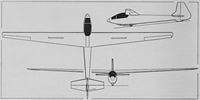
Описание
Страна : Индия
Год : 1970
Планер
Single-seat high-performance Standard Class sailplane
M.Hardy. Gliders & Sailplanes of the world
HS-2 Mrigasheer
India has her own active gliding movement which is Government-sponsored and from time to time holds its own National Championships, but because India's shortage of foreign exchange has precluded the large-scale import of foreign gliders a number of indigenous types have been designed and produced at the Technical Centre of the Civil Aviation Department under the leadership of the Director-General, S. Ramamritham, making use of predominantly local materials in their construction. The first of these gliders, an open-cockpit primary type, made its first flight in November 1950 and since then the Technical Centre has built eight types of sailplane for Indian civil gliding clubs or centres, of which five were original designs. To succeed the earlier KS-II Kartik high performance single-seater the Technical Centre started design of another Standard Class sailplane known as the HS-1, which first flew in November 1970; this had a higher aspect ratio wing than the Kartik's with Wortmann wing sections instead of the earlier design's NACA 64-series aerofoils. This was further developed into the HS-2 Mrigasheer under a design team lead by Mr K. B. Ganesan the centre's Director of Research and Development, and the prototype of this made its first flight in April 1973. The following month it was flown into second place in the first Indian national gliding championships held at Kanpur. A second prototype, based on the aerodynamic design of the first, made its first flight in May 1977; this has trailing edge slotted flaps instead of the first prototype's upper surface air brakes, and a glassfibre reinforced plastic tailplane and elevators of different aerofoil section. The Mrigasheer is of plywood-covered wooden construction and the high wings are two-spar structures with a plywood leading edge torsion box and plywood covering aft of the main spar, the wooden flaps and ailerons being hinged on the rear spar. The semi-monocoque fuselage is plywood-covered, as is the fin, but the rudder is fabric covered. There is a retractable unsprung monowheel with a drum-type brake, as well as a rubber-sprung nose skid with a replaceable steel shoe and a similarly sprung tail skid. The pilot sits under a long forward-opening jettisonable one-piece canopy.
Data: Mrigasheer second prototype
Span: 49 ft 2 1/2 in
Length: 24 ft 10 3/4 in
Height: 8 ft 2 1/2 in
Wing area: 121.0 sqft
Aspect ratio: 19.85
Empty weight: 522 lb
Max weight: 738 lb
Max speed: 132 mph (in smooth air)
Max aero-tow speed: 71.5 mph
Min sinking speed: 1.90 ft/sec
Best glide ratio: 32:1
ATS-1 Ardhra India
This tandem two-seater advanced training sailplane is the latest design of the Technical Centre of India's Civil Aviation Department at New Delhi; it was formerly designated TG-1. The prototype, VT-GEJ, first flew on 5 March 1979 and was certificated by the Indian DGCA in November that year. Plans for large-scale production were under way early in 1980 for the National Cadet Corps and civil clubs. The second prototype which was then under construction has 2° geometric twist (washout) from 50% span to the wing tips, and the dihedral increased to 3°. Of conventional wooden construction with fabric covering the ATS-1 resembles its predecessor, the single-seat HS-II Mrigasheer, although the cantilever shoulder wings have 3° of forward sweep and are plywood-covered multi-spar structures with fabric-covered trailing edges. The plywood plain ailerons are also fabric-covered; no flaps are fitted but there are wooden air brakes in the upper and lower wing surfaces. The tail unit is of similar construction to the wings, with a trim tab in the starboard elevator. The fuselage is a semi-monocoque wooden structure and there is a non-retractable rubber-sprung monowheel with an expanding shoe brake, plus a rubber-sprung skid under the nose and a tail skid. The two pilots sit in tandem under a long one-piece blown flush-fitting canopy.
Data: ATS-1 Ardhra
Span: 54 ft 1 1/2 in
Length: 28 ft 6 in
Height: 8 ft 1 in
Wing area: 235.0 sq ft
Aspect ratio: 12.46
Empty weight: 604 lb
Max weight: 1,000 lb
Max speed: 133 mph (in smooth air)
Max aero-tow speed: 77.5mph
Min sinking speed: 2.56 ft/sec
Best glide ratio: 28:1 at 54 mph
- M.Hardy. Gliders & Sailplanes of the world
Фотографии
-
Jane's All the World Aircraft 1974 / 03 - Sailplanes
Регистрационный номер: VT-XAM Civil Aviation Department HS-I Mrigasheer Standard Class sailplane
-
Jane's All the World Aircraft 1976 / 03 - Sailplanes
Регистрационный номер: VT-GEG HS-II Mrigasheer single-seat Standard Class sailplane
-
Jane's All the World Aircraft 1972 / 03 - Sailplanes
HS-1 Standard Class sailplane designed by the Technical Centre, Civil Aviation Department
-
Jane's All the World Aircraft 1975 / 03 - Sailplanes
Mrigasheer HS-II single-seat Standard Class sailplane
- Фотографии



